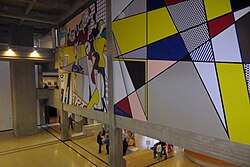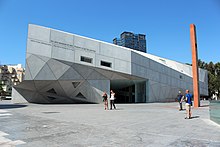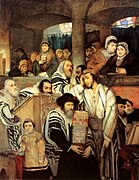Tel Aviv Museum of Art
 From Wikipedia - Reading time: 11 min
From Wikipedia - Reading time: 11 min
מוזיאון תל אביב לאמנות | |
 | |
 Tel Aviv Museum of Art, Main Building | |
 Interactive fullscreen map | |
| Established | 1932 |
|---|---|
| Location | 27 Shaul Hamelech Blvd, Tel Aviv |
| Coordinates | 32°04′39″N 34°47′12″E / 32.07750°N 34.78667°E |
| Type | Art museum |
| Director | Tania Coen-Uzzielli |
| Curator | Suzanne Landau |
| Public transit access | Bus Nos. 9, 18, 28, 70, 90, 111 |
| Website | www |
Tel Aviv Museum of Art (Hebrew: מוזיאון תל אביב לאמנות Muzeon Tel Aviv Leomanut) is an art museum in Tel Aviv, Israel. The museum is dedicated to the preservation and display of modern and contemporary art from Israel and around the world.[1]
History
[edit]
The Tel Aviv Museum of Art was established in 1932 in a building at 16 Rothschild Boulevard that was the former home of Tel Aviv's first mayor, Meir Dizengoff, who had donated the property for a museum in memory of his wife, Zina, following her death in 1930.[2] On 14 May 1948, 250 delegates quietly gathered at the museum[3] for the historic signing of the Israeli Declaration of Independence.[4] In 1971, the building became Independence Hall when the museum relocated to 27 Shaul Hamelech Boulevard.[5]
Curator Nehama Guralnik began working at the museum in 1971, when French was the common language among staff, including the director, administrators and the curators, and catalogues were printed in French and in Hebrew, with English introduced later that decade. Guralnik curated more than 40 exhibitions during her 34-year tenure as international art curator.[6]
The Helena Rubinstein Pavilion for Contemporary Art opened in 1959. Planning for a new building began in 1963 when the museum's collections of modern and contemporary art began to outgrow the premises. Construction commenced in 1966 but stopped for two years due to shortage of funds, before moving to its current location in 1971.[7]
Another wing was added in 1999 and the Lola Beer Ebner Sculpture Garden was established.[8] The museum also contains "The Joseph and Rebecca Meyerhoff Art Education Center", opened in 1988.[9]

The museum houses a comprehensive collection of classical and contemporary art, especially Israeli art, a sculpture garden and a youth wing.[10]
Suzanne Landau, following 34 years at the Israel Museum, was appointed director and chief curator of the museum in 2012.[11]
In 2018, the museum set an all-time attendance record with 1,018,323 visitors, ranking 70th on the list of most visited art museums.[12] In 2019, the museum set a new attendance record, ranking 49th with 1,322,439 visitors.[13] In 2022, it again ranked 49th, with 1,070,714 visitors.[14] In 2023, it was ranked 48th on The Art Magazine's list of the 100 most popular museums in the world.[15]
On 23 March 2023, Tel Aviv Museum of Art was partially closed, in participation with Israel's "day of paralysis"[16] during the 2023 Israeli judicial reform protests.[17] Following the 7 October attacks and subsequent incidents related to the Israel-Hamas War, the Israel–Hezbollah conflict (2023–present) and the 2024 Iran–Israel conflict, the museum removed several items on its collection from display and stored them for safekeeping in a secured basement. It also moved other exhibitions to a protected space on the facility's lower levels.[18]
Permanent collection
[edit]The Museum's collection represents some of the leading artists of the first half of the 20th century and many of the major movements of modern art in this period: Fauvism, German Expressionism, Cubism, Futurism, Russian Constructivism, the De Stijl movement and Surrealism, French art, from the Impressionists and Post-Impressionists to the School of Paris including works of Chaïm Soutine, key works by Pablo Picasso from the Blue and Neo-Classical period to his Late Period, Cubist paintings by Albert Gleizes, Jean Metzinger, several sculptures by Jacques Lipchitz, and Surrealists works of Joan Miró.
One section of the Museum displays the history of Israeli art and its origins among local artists in the pre-state Zionist community of the early twentieth century.
In 1989, the American pop artist Roy Lichtenstein created a giant two-panel mural especially for the Tel Aviv Museum of Art. It hangs in the entrance foyer.[19]
The Collection includes several masterpieces, among them the painting Friedericke Maria Beer, 1916 by the Austrian artist Gustav Klimt and Untitled Improvisation V, 1914, by the Russian master Wassily Kandinsky.
The Peggy Guggenheim Collection, donated in 1950, includes 36 works by Abstract and Surrealist artists, including works of Jackson Pollock, William Baziotes, and Richard Pousette-Dart, and Surrealists works by Yves Tanguy, Roberto Matta, and André Masson.

Sculptures are displayed in the entrance plaza and in an internal sculpture garden.
In addition to a permanent collection, the museum hosts temporary exhibitions of individual artists' work and group shows curated around a common theme.
Buildings of Tel Aviv Museum of Art (21st century)
[edit]The Tel Aviv Museum of Art includes The Paulson Family Foundation Building, its main structure on Shaul Hamelech Boulevard; the Herta and Paul Amir Building; and the Eyal Ofer Pavilion.[20]
Paulson Family Foundation Building
[edit]Marking its 90th anniversary, the museum's main building was refurbished and renamed The Paulson Family Foundation Building in 2021, in honour of its benefactors.[21]
Herta and Paul Amir Building
[edit]In November 2011, the Herta and Paul Amir Building on the western side of the museum opened. It houses an Israeli Architecture Archive, and a new section of Photography and Visual arts. The new building was designed by architect Preston Scott Cohen.[22] The new wing houses 18,500 square feet of gallery space over five floors.[23]
The Amir building also contains Pastel, a fine dining restaurant led by Chef Hilel Tavakuli.[24][25][26]
Eyal Ofer Pavilion
[edit]In May 2023, following an extensive renovation of the Helena Rubinstein Pavilion for Contemporary Art, it was reopened as the Eyal Ofer Pavilion, in honour of its contemporary benefactor,[27] with the first retrospective of the works of Swiss sculptor Alberto Giacometti in Israel exhibited on all four levels. The renovation was led by architect Amnon Rechter, whose father, Israel Prize laureate architect Yaakov Rechter, built the original pavilion in 1959.[28]
Gallery
[edit]-
Portrait of Friederike Maria Beer, Gustav Klimt, 1916
-
The Shepherdess (after Millet), Vincent Willem van Gogh, 1899
-
Rue L´Hermitage, Camille Pissarro, 1866
-
Dome of the rock, Samuel Hirszenberg, 1908
-
Reclining Figure 1969–70, Henry Moore, 1960s
See also
[edit]References
[edit]- ^ "About \ Tel Aviv Museum of Art". www.tamuseum.org.il. Archived from the original on 2020-02-19. Retrieved 2021-10-21.
- ^ Goloperov, Vadim (30 October 2017). "Meir Dizengoff: The Odessan Who Built Tel Aviv". odessareview.com. The Odessa Review. Archived from the original on 28 January 2023. Retrieved 6 April 2023.
- ^ Slavicek, Louise (1 September 2021). The Establishment of the State of Israel. Infobase Holdings, Inc. p. 3. ISBN 9781646936618. Archived from the original on 24 April 2023. Retrieved 6 April 2023. ISBN 978-1-64693-661-8
- ^ "Declaring the State of Israel on May 14, 1948". newsweek.com. Newsweek Digital. 14 May 2015. Archived from the original on 6 April 2023. Retrieved 6 April 2023.
- ^ Raymont, Henry (19 April 1971). "Declaring the State of Israel on May 14, 1948". The New York Times. Retrieved 6 April 2023.
- ^ Gilerman, Dana (21 March 2005). "No Room for Another Ego at the Museum". Haaretz. Retrieved 6 April 2023.
- ^ Tel Aviv's new museum to be dedicated today, New York Times
- ^ "Tel Aviv Museum". Archived from the original on 2007-10-26. Retrieved 2007-02-19.
- ^ "About \ Tel Aviv Museum of Art". Archived from the original on 2015-02-06. Retrieved 2015-02-09.
- ^ Facts and Figures. Israel Office of Information. 1985. p. 121. Archived from the original on 7 April 2023. Retrieved 6 April 2023.
- ^ Riba, Naama (25 November 2020). "After Decades at the Top of the Israeli Art World, Suzanne Landau Is Back With a New Adventure". Haaretz. Archived from the original on 28 August 2022. Retrieved 6 April 2023.
- ^ "Tel Aviv Museum of Art drew over a million visitors in 2018". Haaretz. Archived from the original on 2020-02-05. Retrieved 2020-02-05.
- ^ "Tel Aviv Museum of Art". Archived from the original on 2023-04-05. Retrieved 2023-04-05.
- ^ Cheshire, Lee; da Silva, José (27 March 2023). "The 100 most popular art museums in the world—who has recovered and who is still struggling?". The Art Newspaper. Archived from the original on 28 March 2023. Retrieved 6 April 2023.
- ^ Steinberg, Jessica (4 April 2023). "Tel Aviv Museum of Art among 50 most popular museums worldwide". The Times of Israel. Archived from the original on 5 April 2023. Retrieved 6 April 2023.
- ^ Seymour, Tom (23 March 2023). "Tel Aviv Museum of Art partially closes in support of Israel's 'day of paralysis'". The Art Newspaper. Archived from the original on 6 April 2023. Retrieved 6 April 2023.
- ^ Steinberg, Jessica (22 March 2023). "Tel Aviv Museum of Art to darken galleries in protest on Thursday". The Times of Israel. Archived from the original on 6 April 2023. Retrieved 6 April 2023.
- ^ "Fearing Iran attack, Israeli museum hides top artworks". France 24. 14 August 2024. Retrieved 14 August 2024.
- ^ "Roy Lichtenstein, Tel Aviv Museum Mural". Archived from the original on 2008-11-13. Retrieved 2009-12-23.
- ^ "Buildings and Architecture". Tel Aviv Museum of Art. Archived from the original on 7 April 2023. Retrieved 7 April 2023.
- ^ Galanti, Michael (7 June 2021). "Tel Aviv Museum of Art receives $15m. donation on 90th anniversary". The Jerusalem Post. Archived from the original on 10 April 2023. Retrieved 7 April 2023.
- ^ Tourist Israel (30 October 2011). "Tel Aviv Museum of Art". Archived from the original on 17 March 2021. Retrieved 7 November 2011.
- ^ "Flocking to Tel Aviv Art Museum's new wing". Archived from the original on 2012-06-24. Retrieved 2012-12-12.
- ^ "Pastel in the Tel Aviv Museum is a pleasure for the palate". Archived from the original on 2018-11-17. Retrieved 2018-11-17.
- ^ "The world's most beautiful restaurant... Is in Tel Aviv". Haaretz. Archived from the original on 2018-11-17. Retrieved 2018-11-17.
- ^ "World's most beautiful restaurant is in the Tel Aviv Museum". 28 January 2015. Archived from the original on 18 November 2018. Retrieved 17 November 2018.
- ^ Riba, Naama (17 March 2019). "Tel Aviv Museum Renames Building After Richest Man in Israel". Haaretz. Archived from the original on 25 January 2023. Retrieved 7 April 2023.
- ^ Opening of the first exhibition of Alberto Giacometti in Israel The Jerusalem Post. 7 May 2023.
External links
[edit]- The Tel Aviv Museum of Art
- "Tel Aviv Museum of Art".
 Media related to Tel Aviv Museum of Art at Wikimedia Commons
Media related to Tel Aviv Museum of Art at Wikimedia Commons
 KSF
KSF





